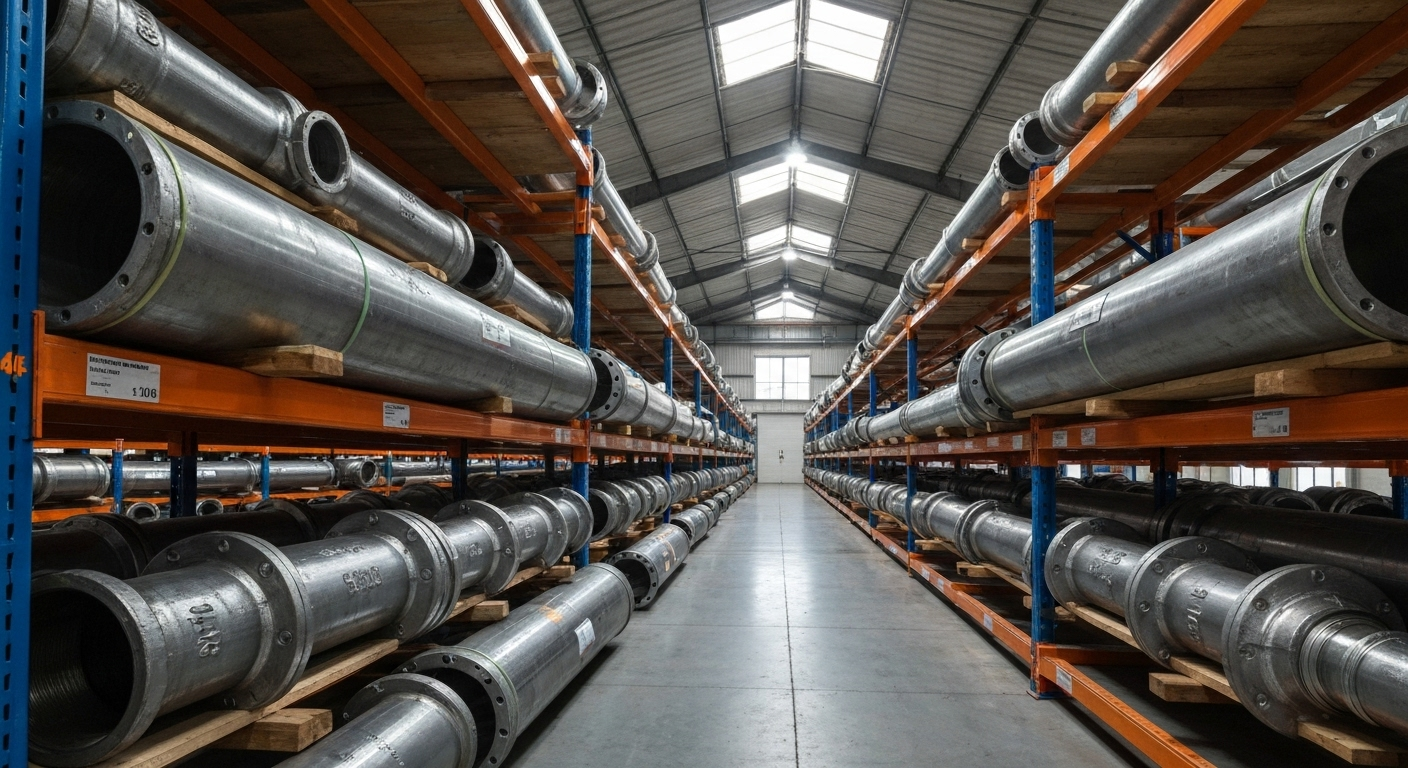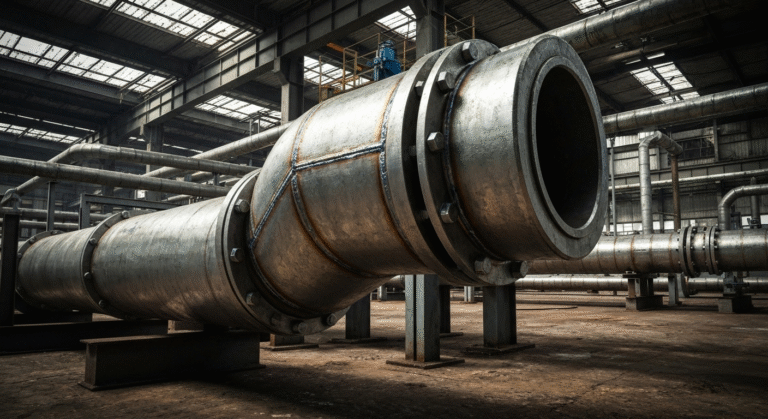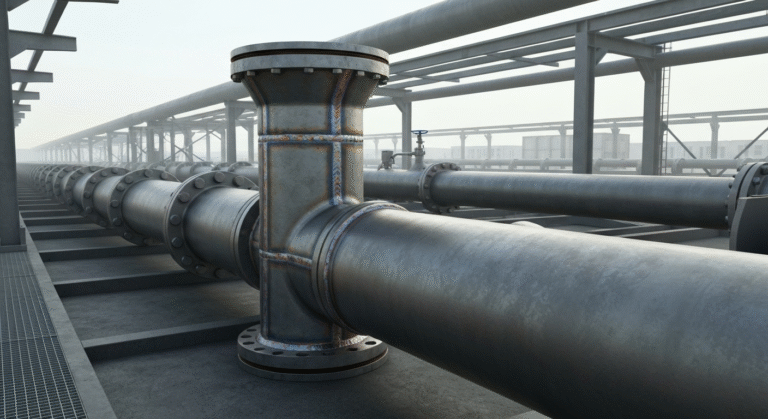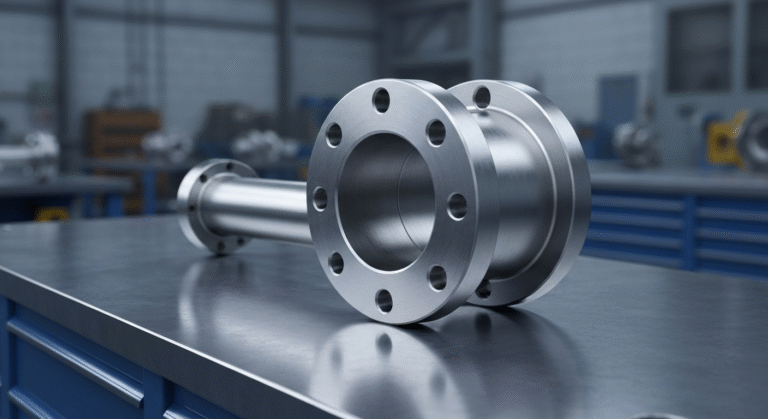-
中国河北省滄州市孟村県銀庄工業区

A234 WPB パイプ継手:品質保証と試験

主なハイライト
- ASTM A234 WPBは、中温から高温のパイプラインシステムで使用される炭素鋼と合金鋼の継手の標準仕様です。
- これらの鋼鉄付属品は、エルボー、ティー、レデューサーのような一般的なタイプを含む、シームレスおよび溶接された形でご利用いただけます。
- 製造には、耐久性のある突合せ溶接継手を作るための鍛造や成形などの工程が含まれる。
- 検査や試験を含む厳格な品質保証により、業界標準への準拠が保証されている。
- 適切な文書化とトレーサビリティは、合金鋼製継手の品質を確認する上で極めて重要です。
- WPBグレード継手の溶接性は、様々な産業用途のための信頼性の高い選択肢になります。
はじめに
安全で機能するパイプラインシステムを構築する場合、すべての部品が高品質でなければなりません。ASTM A234規格は、炭素鋼と合金鋼の管継手の共通規格です。これらの管継手は、中温および高温環境での作業用に作られています。この規格について知っておくことで、人気のあるWPBグレードのような継手を選んでも、作業に十分な強度があることを確認できます。このガイドでは、これらの継手を圧力配管のための信頼できるオプションにするのに役立つチェックとテストを示します。
ASTM A234 WPB パイプ継手の概要

ASTM A234 WPB規格は、炭素鋼と合金鋼から作られる鋼製継手のための規格である。これらの鋼製継手にはシームレスと溶接がある。圧力配管と圧力容器の製造には、両方のタイプの重要な用途があります。これらの合金鋼継手は、中程度と高温の場所でうまく動作するように構築されています。規格は、継手が適切に流体の方向や速度を変更できることを確認するのに役立ちます。
これらの継手のほとんどは、突合せ溶接継手として作られている。一般的なものとしては、エルボー、ティー、レデューサー、キャップなどがある。WPB」ラベルは、鋼材が溶接可能であることを意味する。また、定格圧力も定められている。グレードBは鋼材の最小降伏強度を示し、そのため、その鋼材を信頼して使用することができます。このタイプの鋼は、継手を使用する多くの場所で見られます。このように丈夫で素晴らしい働きをするので、よく目にすることができます。では、この継手がどのように使われ、どのように作られているのかを見てみよう。
定義と主な用途
ASTM A234 WPBは炭素鋼管継手の標準仕様である。アルファベットの意味はそれぞれ異なります:W "は溶接可能、"P "は圧力用、"B "は鋼の最小降伏強度を示すグレードBを意味します。これらの継手は、中温から高温の環境でうまく機能するように作られています。
ASTM A234 WPB継手の主な用途はパイプラインシステムです。パイプを接続したり、流れの方向を変えたり、オイル、ガス、水、スラリーなどの流体がパイプ内を移動する方法を調整するために使用されます。強度が高いため、これらの用途に適しています。
ASTM A234 WPB管継手は、圧力容器の製造にも使用されます。流体の動きを制御し、高温ですべての安全を維持する必要がある場合は、これらの継手は良い選択です。彼らは常に厳格な安全性と性能のルールを満たしています。
一般的な材料と製造プロセス
A234 WPB鋼継手に使用される原材料には、キルド鋼、厚板、棒鋼、シームレスまたは溶融溶接によるパイプなどがある。WPB鋼種の場合、炭素量は0.35%までが多い。マンガンのような重要な元素は厳密に管理されなければならない。炭素が0.01%下がると、マンガンは0.06%上がるが、1.35%を超えることはない。
銅、ニッケル、ニオブ、モリブデンなどの他の元素もミックスの一部であるが、特性を正しく保つためには、これらの元素を制限内に収める必要がある。これらの添加元素の合計は1.00%を超えてはならない。これにより、継手は必要な品質を保つことができます。A234規格に従った合金鋼の継手の中には、使用中により良い性能を発揮するために、クロムやモリブデンを多く含むものもあります。
これらの継手を作るには、鍛造、プレス、ピアス、押し出し、曲げ、融接などの工程がある。鍛造と成形のこれらの異なる方法は、原料を完成した継手に変えるのに役立ちます。継手を作った後は、正しい方法で冷却する必要があるため、継手には欠陥がなく、適切な強度と機能を得ることができる。
主な仕様と業界標準
A234 WPB管継手は、安全で均一な状態を保つため、多くの規則や規格に従わなければなりません。ASTM A234は、材料、製造方法、試験方法に関する主なガイドラインを提供しています。この規格は、サイズと公差の規則を定める他の規格と結合しています。
一般的な継手の規格には、突合せ溶接継手用のASME B16.9と、鍛造継手に焦点を当てたASME B16.11がある。ANSIやASMEのようなグループは、メーカーが使用する規則を作るのに役立ちます。これらの規則は、継手が安全であり、他のすべての部品とうまく機能することを確認します。次のセクションでは、各特性が満たさなければならないものをカバーし、これらの規則に従う方法について話します。
化学的および機械的特性要件
ASTM A234 WPB継手の化学組成は、適切な性能を確保するために厳しく管理されています。WPBグレードの場合、炭素含有量は0.30%、マンガンは0.29%から1.06%に制限されています。リンや硫黄のような他の元素にも厳しい上限がある。銅、ニッケル、クロム、モリブデンの含有量は合計で1.00%を超えてはならず、これは溶接性と強度を維持するために極めて重要である。
化学的特性を超えて、機械的特性は、継手が操作上のストレスに耐えられることを保証するものである。A234 WPB継手は、特定のグレードと材料の厚さによって異なる最小引張強度と降伏強度の要件を満たす必要があります。これらの特性は、継手が圧力下で破損しないことを保証します。
例えば、グレードWPBの場合、降伏強度は最低240MPa(35,000psi)、引張強度は415~655MPa(60,000~95,000psi)でなければならない。硬度も試験され、許容範囲内であることが確認され、材料がもろくなりすぎるのを防ぎます。
プロパティ | WPBグレード要件 |
|---|---|
引張強さ、範囲 | 415-655 MPa [60-95 ksi] |
降伏強度、最小 | 240 MPa [35 ksi] |
炭素(C)、最大 | 0.30% |
マンガン (Mn) | 0.29-1.06% |
リン(P)、最大 | 0.050% |
硫黄(S)、最大 | 0.058% |
シリコン (Si), min | 0.10% |
認証とコンプライアンス
A234 WPB管継手を購入する際は、認証と適合性を確認することが重要である。すべての管継手には、ASTM A234の仕様に適合していることを示す書類があるはずです。こうすることで、継手が正しい方法で作られ、チェックされていることを確認できます。
継手はまた、ASMEやANSIなどの団体が定めたサイズ規格に従わなければならない。例えば、突き合わせ溶接継手はASME B16.9規格に適合しなければなりません。このルールは、サイズ、マーキング、およびどの程度近いものが適合する必要があるかに関するものである。これは、配管継手同士が互いに機能し、継手を入れたときにうまく収まるようにするためのものです。これは、配管システムが丈夫で安全であるために必要なことです。
認証とコンプライアンスをチェックすることで、各フィッティングが安全で、うまく機能し、本来の仕事をすることを確認することができます。新しい継手を使用する前に、必ず材料試験報告書(MTR)とその他必要な書類を要求し、見てください。これにより、配管継手が必要なすべての規則を満たしていることを確認できます。
A234 WPB パイプ継手の種類
ASTM A234 WPB規格は、あらゆる種類のパイプラインシステムの構築に必要な管継手です。これらの突き合わせ溶接継手は、パイプに溶接するように作られています。これは、強力な、漏れのない接続を毎回与える。多くのタイプから選べるため、流れの方向を変えたり、ラインを分岐させたり、必要な部分のパイプを小さくしたりと、さまざまなことが可能です。
一般的な継手には、90度ベンドと45度ベンドがある。これらのベンドは、パイプの中を流れる方向を変えたいときに使う。ティーは、メインパイプから分岐させるのに役立ちます。レデューサーは、あるパイプサイズから別のサイズに移動する必要がある場合に使用します。また、キャップはパイプの端を塞ぐために使用します。では、これらの異なる継手の種類を紹介し、パイプライン・システムで使用する他の継手との比較を見てみよう。
バット溶接、ソケット溶接、その他の継手タイプ
A234規格で使用される最も一般的な継手は、突き合わせ溶接継手である。この継手は、ステンレス鋼の両端が斜めにカットされている。パイプと並べると、漏斗のような形状になり、中までしっかりと溶接される。こうすることで、内面が滑らかになり、圧力の低下やパイプ内の渦巻きが少なくなる。
一方、ソケット溶接継手にはスペース(ソケット)があり、そこにパイプを入れてから外側を隅肉溶接する。ソケット溶接継手は、パイプを差し込んでから外側を隅肉溶接します。この隙間は、場合によっては錆の原因になることもある。突き合わせ溶接継手もソケット溶接継手も、パイプの直径や肉厚に合うよう、サイズやSchを組み合わせて入手できる。
一般的なフィッティングタイプの簡単な比較です:
- 突合せ溶接継手: 強力で完全な溶接を実現する。高圧、高熱のセットアップに適している。
- ソケット溶接継手: 取り付けは簡単だが、通常は圧力が低い細いパイプに使用される。
- Threaded Fittings: These are screwed together and are good for low-pressure spots where welding might not work.
Comparison with Other Carbon Steel Fittings
Within the ASTM A234 specification, the most common carbon steel grade is WPB. But it is not the only one. Another type is WPC, which has a higher limit for carbon. WPC allows up to 0.35% carbon, while WPB is at 0.30%. This small change in carbon amount can affect things like how well the steel fittings can be welded and how strong they are.
The main way WPB is different from other carbon steel grades is in the set limits for manganese, silicon, copper, and some other alloys. WPB fittings have a good balance. They are strong and can be welded easily. That makes them useful for many jobs with both high and moderate heat.
When you look at alloy steel fittings, some like WP5 or WP9, that also fall under the A234 standard, the changes are much bigger. These alloy steel fittings have more chromium and molybdenum. Those parts give them extra strength and better protection against rust and damage. That is why alloy grades work well in places that are tough and where things might corrode.
You should pick between WPB, WPC, or alloy steel fittings based on what your system needs. The right choice comes down to the system’s pressure, the temperature, and what is flowing through it.
Quality Assurance Measures in A234 WPB Fittings

Making sure A234 WPB fittings are good starts with a strong quality check system. This begins by getting the right certified raw materials. The process covers every step of making the fittings. Careful checks and tests are done to see that each part matches the strict chemical and mechanical rules the ASTM standard asks for.
Some important steps for quality include complete checking, full traceability, and keeping good records. All these help make certain that each fitting has no faults and meets every standard. So you know it works well. Next, we will look at these quality control steps for fittings and ASTM WPB in more detail.
Inspection Protocols and Quality Control Steps
A strong inspection routine is very important for making sure A234 WPB fittings are good quality. First, the people in charge check the raw materials to see if they have the right chemical makeup and to make sure there are no problems with them. During manufacturing, and especially after forming steps like forging, each fitting is checked by looking at it and measuring it.
The main purpose of these checks is to find and remove any problems or mistakes, like if something is wrong with the weld. Each fitting must meet the size standards set by rules like ASME B16.9. This helps make sure the fitting goes in right and the pipeline stays strong.
Key inspection and quality checks for fittings include:
- Visual Inspection: Looking for problems on the surface, cracks, or anything else that should not be there.
- Dimensional Checks: Making sure the diameter, wall thickness, and bevel angle are correct.
- Material Verification: Testing or reviewing documents to confirm the grade and what the fitting is made of.
- Marking and Stamping Review: Checking that all needed information is marked for rules and tracking.
These checks are needed to make sure wpb fittings work the way they should with each use. The right thickness and diameter are important, and checking them to fit ASME standards helps avoid trouble and keeps everything working well.
Traceability and Documentation Practices
Traceability is a key part of making sure fittings like A234 WPB fittings meet high standards. It helps you track each fitting from when it is put in all the way back to the raw stuff it was made from. Most of the time, each part has a unique heat number or a special code stamped or marked on it.
This is very important for control and knowing who is responsible. If there is ever a problem with the fitting, you can track down the whole batch, find out what went wrong, and fix it. Without this, it would be hard to know where the fitting came from or if it has good quality.
Having the right papers is also important to prove this tracking and to show the fittings follow all the rules. Things like a Material Test Report (MTR) go with each fitting. These documents give details about the stuff used to make it, test results, and a note that it passes the ASTM A234 specification. These papers are your proof that the product meets every standard it should.
Testing Procedures for A234 WPB Pipe Fittings
To check if A234 WPB fittings are good, makers do many tests. The steps they use help to make sure the metal is strong and matches what is needed by the specification, and that each fitting does not have any hidden problems. This is very important when the part will be used in pressure piping, where it faces a lot of stress.
The testing has two main parts. Some tests look at mechanical things like how much strength the material has and how hard it is. Other tests, called non-destructive testing (NDT), look for problems inside without breaking the fitting. These steps give the last check on if each fitting can be used.
Now, let’s talk about the ways these tests are done and what a fitting must show to pass and be used in pressure piping systems.
Mechanical and Non-Destructive Testing Methods
Mechanical testing is done on samples from every production batch. This checks that the material in the fittings meets the needed properties for pressure piping systems. These tests break the fitting to see if it has enough strength and flexibility. The results are checked against the minimum limits in the ASTM A234 specification.
Apart from these tests, there can be non-destructive testing (NDT) to look for hidden defects in the fittings. NDT uses things like magnetic particle, liquid penetrant, or radiographic methods. These help find cracks or holes that you can’t see by just looking at the fitting. It is very important for welded fittings because you want to make sure the fusion is solid.
Common ways to test include:
- Tensile Test: Checks the highest strength the material can take before breaking and the point where it starts to stretch.
- Hardness Test: Makes sure the fitting is not too hard or brittle, so it will not break easily. Testing is usually done on at least two pieces from every batch.
- Hydrostatic Test: Makes sure the fitting can handle the needed inside pressure without leaking or giving way.
- Non-Destructive Testing (NDT): Finds problems in and under the surface without hurting the part.
So, these tests help confirm that all fittings for pressure piping follow the ASTM specification and are safe to use. This makes sure their fusion and strength are good for the job.
Acceptance Criteria and Test Reporting
After the testing is done, the results are checked with the acceptance criteria. These rules are set by the ASTM A234 specification and other standards. For fittings to be passed, their chemical and mechanical features must be in the right critical range and other specified ranges. If any fitting from a group does not match these rules, it does not pass.
All the results from the tests are put together in a formal document called a Material Test Report (MTR) or test report. This record is a big part of quality assurance. It is kept as proof of the properties of the fittings and shows that they meet the needed specification.
When you get A234 WPB fittings, it’s important to ask for and look at the MTR. This report should show the right material grade, the chemical analysis, details about the mechanical test results such as tensile and yield strength, and say that the fittings are made as per the ASTM A234 standard. This is a key step to help make sure it is safe and good quality.
Welding Suitability and Performance Characteristics
The “W” in WPB shows that these fittings can be welded. This is an important part of how they work. Their makeup is made to help with weldability. It means you can join them strongly to your pipes. This helps build pipeline systems that do not leak when you use normal welding methods.
To get good welding results, you need to choose the right filler metal. You also need to use steps that are known to work well. These steps help you get full fusion without making mistakes. If you put in A234 WPB fittings the right way, they work well in the industrial fields where you need them.
The next parts will talk about the things that can change weldability. Also, the next sections cover how they perform for different industries.
Weldability Factors for A234 WPB Pipe Fittings
The good weldability of A234 WPB pipe fittings comes from their controlled chemical makeup. Limits on carbon and other parts help to stop cracking when you weld and cool the metal. Thanks to this careful mix, welding is easy on pipe fittings with normal thickness. Sometimes, if the fittings are thicker, this could change and may need more care.
To get a strong weld, you need more than just a good fitting. You must get the joint ready. Clean the ends and bevel them for the best fusion. Pick the right filler metal. It has to match the base part. Then the weld can be as strong as the pipe and fittings.
You should also control how you weld. Things like the heat you use and how fast you move can change how strong the weld is. When fittings with a wall thickness of 3/4 inch or more are welded by fusion, you must usually do a heat treatment after welding. This helps to release any stress left in the pipe fittings. It makes sure the fittings and weld will work well.
Performance Across Different Industrial Sectors
ASTM A234 WPB pipe fittings are known for their solid performance. You will see them used in a lot of industrial areas. These fittings work well when the temperature and pressure levels are not low. That is why people in the oil and gas industry use them for pipeline systems in many stages, including upstream, midstream, and downstream.
In power plants, these pipe fittings help build the steam and water piping. This is true for both fossil fuel and nuclear power plants. Their steady performance makes these places safe and helps everything work the way it should. You also find pipe fittings joined with valves and other tools. These connections guide the flow in complex systems.
Many other places use A234 WPB fittings too. Chemical plants, water treatment centers, and manufacturing companies pick them for different jobs. If there is the need to move liquids safely through pipeline systems with pressure, these fittings give you a cost-saving and lasting answer. They help create strong networks that get the job done right.
結論
A234 WPB pipe fittings are important for many industries. They help keep things safe and running well in different jobs. It is good to know about the rules, quality checks, and tests before you use or pick these pipe fittings. When you follow the right steps and use strong quality control, you can trust in the work and life of these fittings.
If you are looking for fittings for building or for making things, picking good A234 WPB fittings can really help your project come out well. If you want to buy A234 WPB pipe fittings, look for trusted suppliers. Make sure they can give you papers that show their pipe fittings are safe and meet the needed rules. This helps you get what you need and keeps your work on track.
よくある質問
What industries most commonly use A234 WPB pipe fittings?
ASTM A234 WPB fittings be used a lot in pipeline systems and other types of pressure piping. You can find them in oil and gas mainly, as well as power plants and chemical plants. They have to work well when the heat is up and work for a long time. That is why they get picked for the job in these places.
How do I verify the certification and quality of A234 WPB fittings?
To check quality, you should always ask for the Material Test Report (MTR) or paperwork that shows certification when you buy something. This report lets you know that it meets the ASTM A234 specification. It gives details about the chemical analysis and the results of mechanical tests. This is an important step for good quality assurance.
Are A234 WPB pipe fittings available for online purchase in the United States?
Yes, you can find ASTM A234 WPB steel fittings from many industrial suppliers all over the United States. A lot of these places let you buy fittings on their websites. This makes it easy to get the steel fittings and other fittings you need that match your project’s astm wpb specification, right from the internet.
コンセントリック・レデューサーとは何ですか?
A concentric reducer is a type of pipe fitting that connects two pipes of different diameters while maintaining a symmetrical profile. This fitting allows for a smooth transition between sizes, ensuring consistent fluid flow and pressure throughout the system, making it essential in various piping applications.


